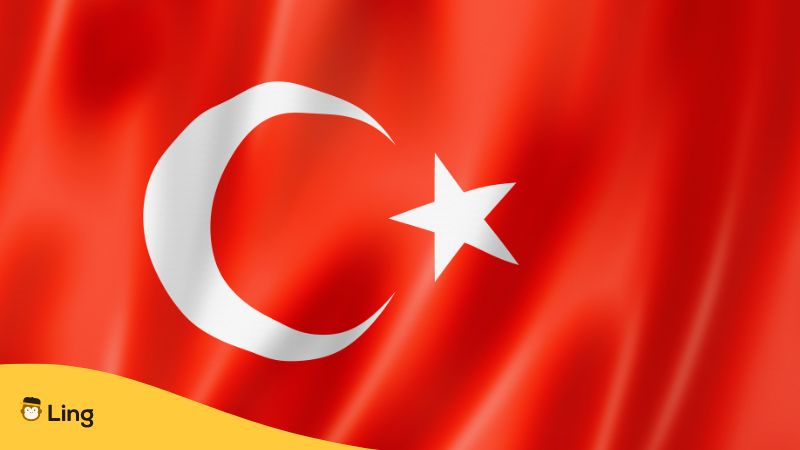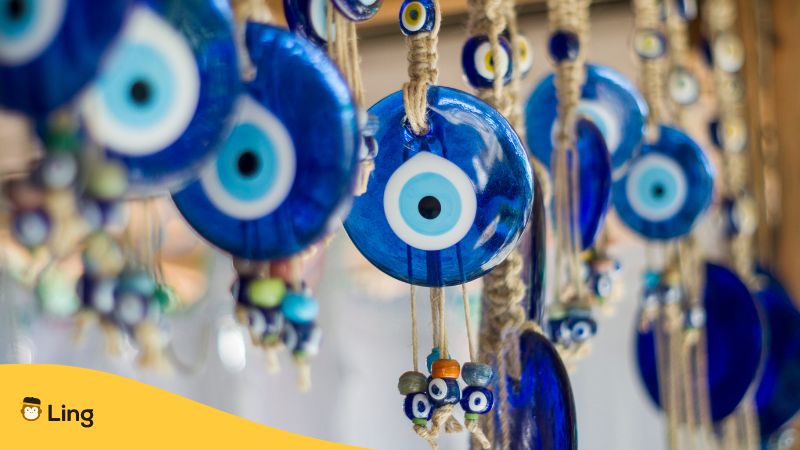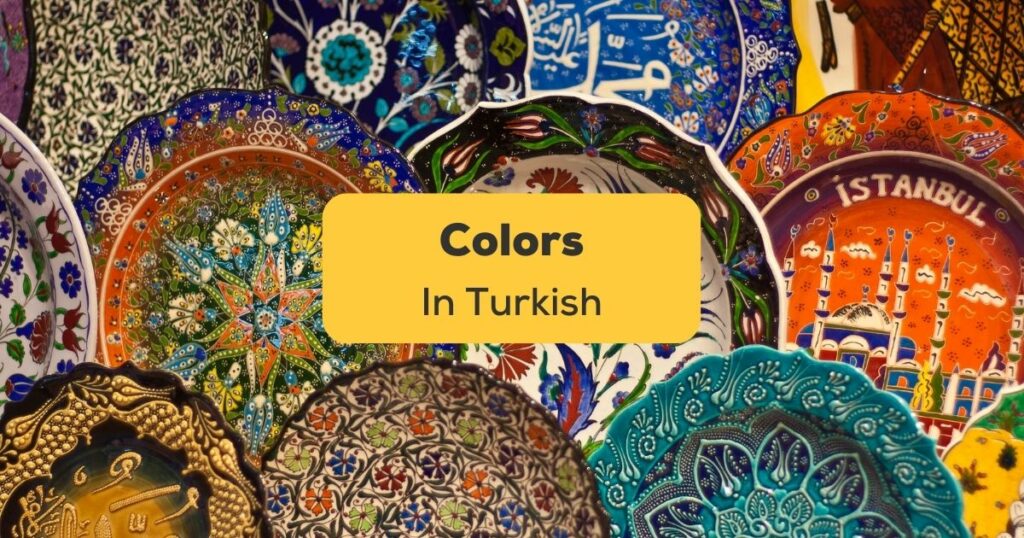If you already admire traditional Turkish art, it is your sign to learn colors in Turkish now!
Turkish art is well-known for its colorful and vivid style. If you ever visit a Turkish art museum, let me tell you what you’ll see inside: A set of painted tiles and ceramic pottery, mostly in eye-catching blue; handmade silk carpets, mostly in red; colorful Turkish marbling and some Islamic calligraphy.
If you have been learning Turkish for a while now, you probably realize that the Turkish language is as rich as Turkish culture. And if you know colors in Turkish vocabulary, you can talk about an art piece and appreciate it from another perspective.
So, in this blog post, you’ll learn the color vocabulary in Turkish and a few distinctive colors with their meanings in Turkish culture.
Page Contents:
- Symbolic Colors Of Turkey
- What’s The Relation Between Turquoise And Turkey?
- Learn Colors In Turkish
- How To Emphasize Colors In Turkish?
- Color Shades In Turkish
- Learn Turkish With Ling App!
Symbolic Colors Of Turkey
As I mentioned above, Turkish art has some distinctive colors, such as blues and reds, which are very common in traditional Turkish artwork. Still, there are also some other symbolic Turkish colors you must know.
Let’s learn why these colors are significant in Turkish culture and what meanings they hide!

Red – Kırmızı
Red is a powerful color for Turks since it is the color of the Turkish flag, and hence red is a symbol of Turkish nationalism.
Red also symbolizes virginity. Traditionally, women wear a red belt known as the chastity belt on their wedding day. However, it is no longer a popular tradition in modern society.
Women often wear a red veil on their heads on the wedding day or henna night because it is believed that red brings luck to weddings.
Red is also the color of the famous Turkish tea, çay.
In general terms, red signifies intense feelings such as passion and anger.

Blue – Mavi
It’s believed that blue has a healing effect and is a repellent against evil; that’s why the evil eye, “Nazar boncuğu,” is blue.
Blue is a must-have color in traditional Turkish art, such as “çini,” the art of painting glazed tile and ceramics.
Blue is also associated with the sky; hence it symbolizes Göktengri (God) in Turkic shamanistic religion. This is why many Turkic countries include blue in their flags.
Blue is also a symbol of famous seaside resorts in Turkey. If you visit Antalya or Muğla, you’ll see the brightest shades of blue in hidden coves!

Green – Yeşil
Green is usually associated with Islam and was also the color of the Ottoman flag.
Green reminds me of the Black Sea Region in Turkey because it is the greenest region, with huge forests, steep mountains, limpid waterfalls, and wooden cottages, in the country. The nature there is totally worth seeing!
In a broader aspect, the green color represents nature and life.
What’s The Relation Between Turquoise And Turkey?
Turquoise is a unique color mixture of blue and green, which is actually named after a mineral. Turquoise is derived from the French word “turquois,” which means Turkish.
The reason behind it is that the mineral was first brought to Europe through Turkey from mines in the historical Khorasan province of Iran. However, the first recorded use of turquoise as a color name in English was in the 16th century.
After providing you with some cultural knowledge, let’s get to the language-learning part!
Learn Colors In Turkish
Colors are a must-know topic in A1 Turkish and are super easy. I’m sure you can memorize them in a very short time as enthusiastic Turkish learners, right?
How To Emphasize Colors In Turkish?
The good news is that it doesn’t require any vowel harmony rules. Yay! To emphasize the color in Turkish, you should reduplicate the color itself.
Take the first syllable of the color name and attach one of those consonants, “p, m, s, r,” at the end of that syllable. Then add the newly formed syllable to the beginning of the actual color name. Here is an example for you:
Example: Siyah = si (the first syllable) + m = Simsiyah
- Simsiyah – Pitch black
- Bembeyaz – Snow white
- Kıpkırmızı – Bright red
- Masmavi – Bright blue
- Yemyeşil – Bright green
- Mosmor – Deep purple
- Pespembe – Light pink
- Sapsarı – Bright yellow
Color Shades In Turkish
Sometimes, we can’t be sure about the color, but it kind of looks like a shade of it. In those times, we say -ish colors like bluish. Now, you’ll learn how to add that -ish in Turkish colors.
You need to use the suffix -(i, ı)mtrak, which is used to produce adjectives that describe the color.
The suffix -(i)msi is also used for the same function.
If you want to learn more about Turkish and improve your language level, the Ling App can help you!
Learn Turkish With Ling App!
If you are thinking about learning Turkish or other languages, waste no more time and check out the Ling App to start a Turkish lesson at home today!

Ling is a language-learning app designed to assist all language learners from beginning their language-learning journeys. The app consists of different engaging activities, from writing and listening exercises to an AI chatbot to practice your speaking skills, and with much more, the Ling App offers you everything you’re looking for in a language learning app.
Also, don’t forget to check out our Turkish blog for weekly articles about the Turkish language and culture!
Trust me; you won’t regret it if you try Ling for FREE by downloading it from the App Store or Play Store.
Untill next time! Görüşmek üzere!































































One Response
I think also You should say on the Turkish flag that the blood of martyrs who died for the sake of the homeland is red